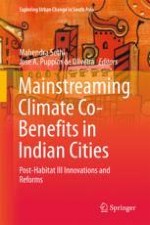2018 | OriginalPaper | Chapter
7. Co-benefits from Buildings and Construction
Author : A. Narender
Published in: Mainstreaming Climate Co-Benefits in Indian Cities
Publisher: Springer Singapore
Activate our intelligent search to find suitable subject content or patents.
Select sections of text to find matching patents with Artificial Intelligence. powered by
Select sections of text to find additional relevant content using AI-assisted search. powered by
